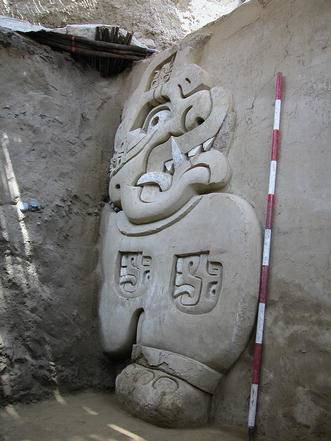The feline of Huaca Partida is a significant artifact discovered in Peru. It represents the Moche culture, known for its pottery, architecture, and artwork. This artifact, depicting a feline figure, offers insights into the religious and symbolic practices of the Moche people. The discovery of the feline figure has sparked interest among historians and archaeologists, leading to various interpretations of its purpose and significance.
Get your dose of History via Email
Historical Background of the Feline of Huaca Partida
Archaeologists unearthed the feline of Huaca Partida in Northern Peru. The Moche civilization, which flourished between 100 AD and 800 AD, created it. The Moche are famous for their mastery in art and architecture. The discovery of the feline figure was a breakthrough in understanding Moche iconography. It was found at the Huaca Partida archaeological site, a place rich with historical artifacts. The site has revealed much about the Moche’s way of life.
The Moche built Huaca Partida, and the feline figure is a testament to their craftsmanship. The Moche did not have a written language. Thus, artifacts like the feline figure are crucial for understanding their culture. The site, over time, has attracted various inhabitants. However, the Moche’s influence remains the most significant. The feline figure has not been linked to any specific historical events. Yet, it is an important piece in the puzzle of Moche society.
The discovery of the feline figure was made by a team of archaeologists led by Dr. Santiago Uceda. The exact date of discovery is not widely publicized. However, it is known that the Moche civilization has been the subject of study since the late 19th century. The feline figure was found during one of the many excavations aimed at uncovering Moche artifacts.
The Moche civilization is known for its ceremonial centers, like Huaca del Sol and Huaca de la Luna. Huaca Partida may not be as well-known as these sites. However, it has provided valuable artifacts like the feline figure. These artifacts help historians piece together the cultural practices of the Moche. The site continues to be an area of interest for archaeologists and historians alike.
While Huaca Partida has not been the scene of any known historical battles or events, it remains an important cultural site. The feline figure is just one of many artifacts that offer a window into the past. It helps us understand the religious and societal structures of the Moche civilization.
About the Feline of Huaca Partida
The feline of Huaca Partida is a ceramic artifact. It depicts a stylized feline, which is a common theme in Moche iconography. The Moche often used animals to represent natural forces and deities. The feline figure is no exception. It is a symbol of power and mystery within the Moche belief system.
The artifact is made from terracotta, a material widely used by the Moche. The feline figure showcases the Moche’s advanced ceramic techniques. They were known for their ability to create lifelike figures and intricate designs in their pottery. The feline figure’s detailed workmanship is a prime example of their skill.
The construction of the feline figure involved several stages. First, the Moche artisans would have shaped the clay. Then, they would have decorated it with paints made from natural dyes. Finally, they would have fired it in kilns to harden the ceramic. This process was typical for Moche pottery, resulting in durable and vibrant artifacts.
Architectural highlights of the site where the feline was found include platforms and truncated pyramids. These structures were common in Moche ceremonial centers. They served as stages for religious rituals and public gatherings. The feline figure may have played a role in such ceremonies, possibly as an offering or a symbol of divine presence.
The feline figure’s design and construction methods align with the Moche’s artistic traditions. It stands as a testament to their cultural and religious beliefs. The artifact’s preservation allows modern-day scholars to study and appreciate Moche craftsmanship.
Theories and Interpretations
Several theories exist about the feline of Huaca Partida. Some scholars suggest it was used in religious ceremonies. Others believe it may have served as a totemic object, embodying the power of the feline in Moche culture. The exact purpose of the figure remains a subject of debate among experts.
The mysteries surrounding the feline figure include its specific role in Moche society. Was it a deity representation, a symbol of royalty, or something else? The lack of written records from the Moche civilization makes it challenging to determine the figure’s exact significance.
Interpretations of the feline figure often rely on matching its imagery with other Moche artifacts. By comparing the figure to other depictions of felines in Moche art, historians attempt to understand its meaning. These comparisons have led to a broader understanding of Moche iconography and mythology.
Dating of the feline figure and other artifacts from Huaca Partida has been carried out using methods like radiocarbon dating. These techniques help establish a timeline for the Moche civilization and its artifacts. The feline figure fits within the broader context of Moche cultural artifacts, dating back to their era of prominence.
The feline figure continues to be a subject of study. As new discoveries are made at Huaca Partida, the understanding of the figure’s significance may evolve. For now, it remains an intriguing piece of Moche heritage, open to interpretation and study.
At a glance
Country: Peru
Civilization: Moche
Age: 100 AD – 800 AD
Conclusion and Sources
Reputable sources used in the creation of this article include:
- Wikipedia: https://en.wikipedia.org/wiki/Moche_culture
- Image credit: Research Gate

